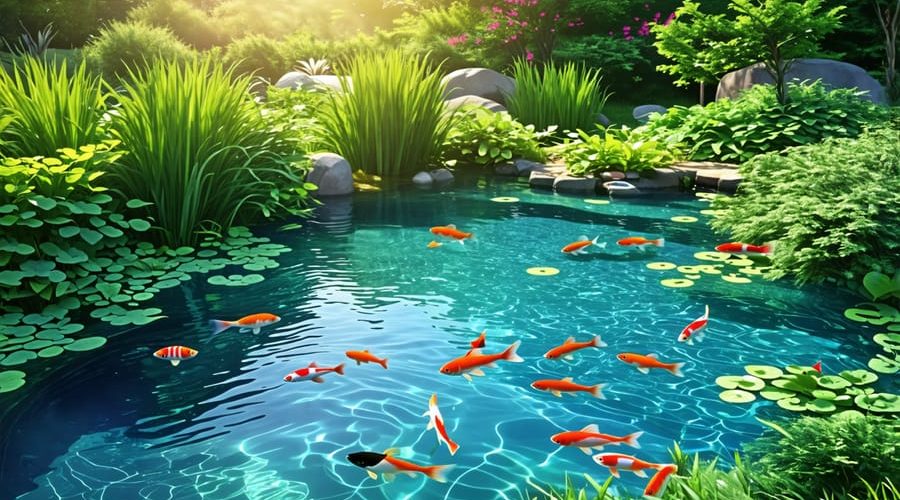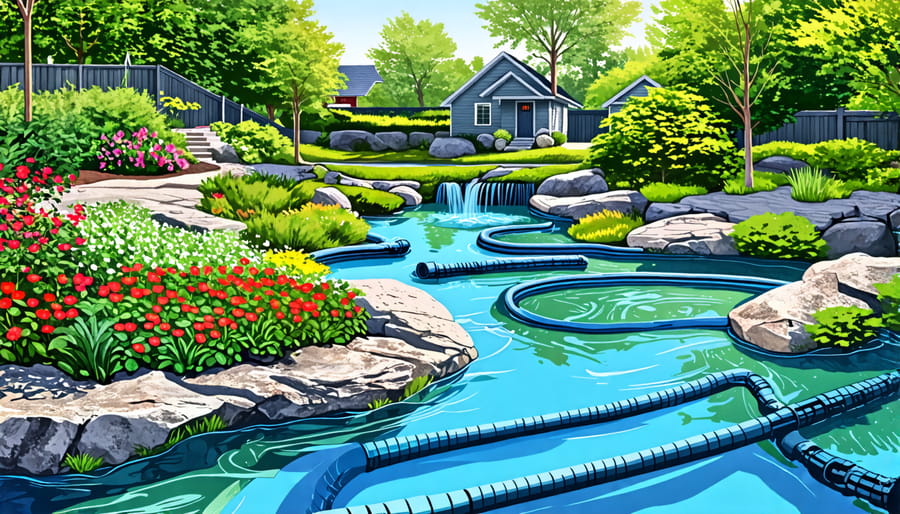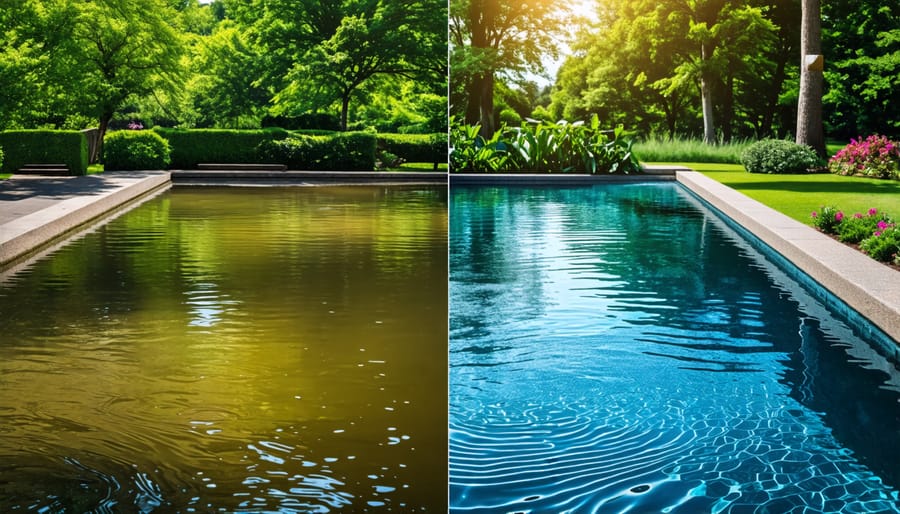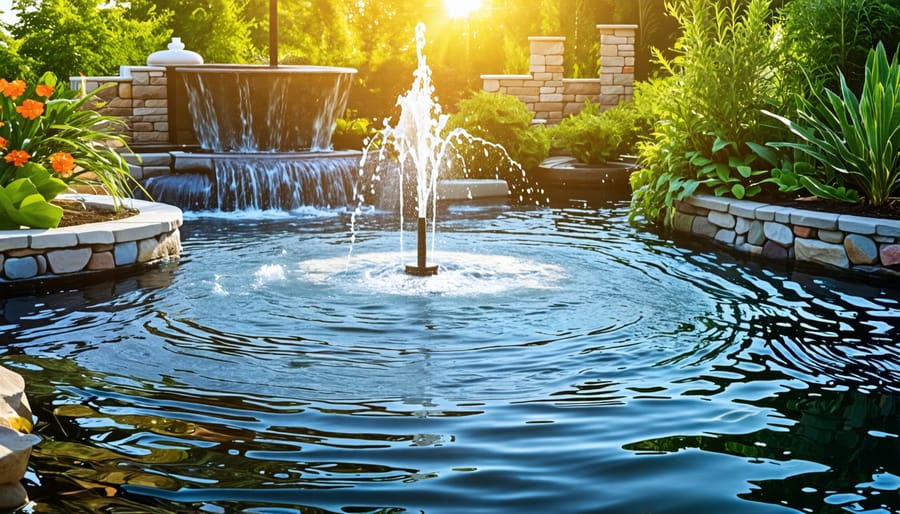
7 Secrets to Keep Your Pond Water Crystal Clear with Circulation
Install a proper aeration system to oxygenate your pond, creating a healthy environment for beneficial bacteria that break down organic matter and prevent stagnation. Choose the right pond pump based on your pond size and water volume to ensure adequate circulation and filtration, removing debris and excess nutrients. Incorporate a skimmer or overflow into your pond design to remove surface waste like leaves and foam, maintaining crystal clear pond water. Regularly clean and maintain your pump, filter media, and skimmer to optimize their performance and prevent clogs that can hinder water circulation efficiency.
Understanding Pond Water Circulation

The Role of Oxygen
Oxygen plays a vital role in maintaining a healthy pond ecosystem. A well-designed pond water circulation system promotes oxygenation by constantly moving water, exposing it to the air and allowing oxygen to dissolve into the water. This dissolved oxygen is essential for the survival of fish, plants, and beneficial bacteria in your pond.
Without adequate oxygen levels, fish may become stressed, susceptible to disease, or even die. Aquatic plants also require oxygen for respiration and growth. Moreover, beneficial bacteria, which break down organic matter and help maintain water clarity, need oxygen to thrive.
By ensuring proper circulation and oxygenation, you create a balanced and healthy environment for all pond inhabitants. This not only enhances the overall aesthetic appeal of your water garden but also minimizes the risk of stagnation, algae growth, and unpleasant odors.
Preventing Stagnation
Proper water circulation is essential for maintaining a healthy pond ecosystem. Without it, dead zones can form where water becomes stagnant and depleted of oxygen. These areas create an ideal breeding ground for harmful algae and bacteria that can quickly take over your pond. Stagnant water also poses a serious risk to fish, as they may suffocate in oxygen-poor conditions.
A well-designed pond water circulation system works to prevent these issues by keeping the water moving and evenly distributing oxygen throughout the pond. By eliminating dead zones and ensuring consistent water quality, circulation systems promote a balanced environment where fish and beneficial bacteria can thrive. Additionally, the constant movement of water helps prevent the build-up of organic debris and waste, which can further contribute to algae growth and poor water clarity. Investing in a proper circulation system is a crucial step in maintaining a beautiful, healthy pond that you can enjoy for years to come.

Benefits of a Pond Circulation System
Clearer Water
A pond water circulation system helps keep your water crystal clear by constantly moving the water through a filtration process. As the water flows, it carries debris and particulates towards the filter, which traps and removes them from the pond. This continuous filtration prevents the build-up of organic matter and keeps the water transparent. Circulation also promotes oxygenation, which is essential for beneficial bacteria that break down waste and maintain a healthy, clean pond environment. With a well-designed circulation system, you’ll enjoy the beauty of your pond with minimal maintenance, as the water remains clear and free of unsightly debris.
Healthier Fish and Plants
A well-designed pond water circulation system not only keeps the water crystal clear but also creates a healthier environment for fish and plants. By circulating the water, the system ensures that oxygen levels remain consistent throughout the pond, reducing stress on fish and preventing stagnant areas where harmful bacteria can thrive. This oxygenation also promotes the growth of beneficial bacteria, which break down organic matter and keep the water clean. Additionally, the constant movement of water helps distribute nutrients evenly, allowing plants to absorb them more efficiently and grow more vigorously. As a result, you’ll notice your fish becoming more active and vibrant, while your aquatic plants display lush, green foliage. By investing in a pond water circulation system, you’re creating an ecosystem where thriving pond life can flourish, ensuring a beautiful and balanced water garden for years to come.
Fewer Mosquitoes and Pests
One of the major benefits of installing a pond water circulation system is that it helps control mosquitoes and other pests. Mosquitoes are attracted to stagnant, still water for breeding. By keeping your pond water moving, you create an inhospitable environment for mosquito larvae, effectively reducing their population. The constant motion also deters other pests like flies and gnats from settling around your pond. With fewer annoying insects buzzing about, you can enjoy a more pleasant and comfortable outdoor experience. Plus, minimizing mosquitoes helps protect you and your family from potential diseases they may carry. A well-designed circulation system is an eco-friendly way to maintain a healthier, pest-free pond.

Types of Pond Circulation Systems
Fountain Pumps
Fountain pumps are a popular choice for circulating water in ponds. They work by drawing water from the pond and propelling it upwards through a fountain head, creating an attractive spray pattern. The falling water helps aerate the pond, promoting healthier water conditions. Fountain pumps come in various sizes and styles, making them suitable for ponds of different dimensions. They are relatively easy to install and maintain, and can add a beautiful aesthetic element to your pond.
However, fountain pumps may not provide sufficient circulation for larger ponds or those with heavy fish populations. They also tend to be less energy-efficient compared to other circulation methods. Fountain pumps work best in smaller, decorative ponds where the primary goal is to create a visually appealing water feature. When selecting a fountain pump, consider factors such as pond size, desired spray height, and energy consumption to ensure optimal performance and enjoyment of your pond.
Submersible Pumps
Submersible pumps are the heart of a pond’s water circulation system. These pumps are placed underwater, typically at the bottom of the pond, and work by drawing water in and pushing it out through a connected hose or pipe. The main advantage of submersible pumps is their ability to efficiently circulate water without being visible, maintaining the pond’s natural aesthetic. They also tend to be quieter than external pumps and require less maintenance.
When placing a submersible pump, consider the pond’s size, depth, and desired water flow. Ideally, position the pump in the deepest part of the pond, away from debris and sediment that could clog the intake. Ensure the pump is powerful enough to turn over the pond’s entire volume of water at least once every hour for optimal circulation and filtration. With proper placement and sizing, a submersible pump will keep your pond’s water moving, aerated, and healthy for years to come.
Paddlewheel Aerators
Paddlewheel aerators are a popular choice for pond water circulation and oxygenation. These devices feature a series of paddles attached to a rotating wheel, which is powered by an electric motor. As the paddlewheel spins, it agitates the water surface, creating a splashing effect that introduces oxygen into the pond. This process helps to maintain healthy dissolved oxygen levels, which are crucial for the survival of fish, plants, and beneficial bacteria. Paddlewheel aerators are most effective in shallow ponds or those with a large surface area, as they primarily oxygenate the top layer of water. They are also well-suited for ponds with heavy organic loads or high fish populations, as they can help prevent oxygen depletion. When selecting a paddlewheel aerator, consider factors such as pond size, depth, and the desired level of oxygenation to ensure optimal performance and water quality.
Choosing the Right Circulation System
Considering Pond Size and Depth
When selecting a pump for your pond’s water circulation system, consider the pond’s size and depth to ensure adequate flow rate. As a general rule, the pump should be able to circulate the entire pond volume once every 1-2 hours. To calculate the necessary flow rate, multiply your pond’s length, width, and average depth in feet to determine its volume in cubic feet. Then, multiply that volume by 7.5 to convert it to gallons. Divide the total gallon volume by the desired turnover time (in hours) to find the required gallons per hour (GPH) flow rate. For example, a 10′ x 15′ pond with an average depth of 3′ would have a volume of 450 cubic feet or approximately 3,375 gallons. To circulate this volume once every 2 hours, you would need a pump with a flow rate of at least 1,688 GPH. Always choose a pump with a slightly higher flow rate than required to account for friction loss in pipes and fittings.
Matching to Pond Type
When selecting the optimal circulation system for your pond, it’s important to match the method to your specific pond type. For koi ponds, which typically house a higher density of fish and require crystal-clear water, a powerful skimmer and bottom drain setup is ideal. This combination effectively removes debris from the surface while pulling waste from the pond floor, maintaining pristine conditions for your prized koi.
In contrast, water gardens prioritize aesthetics and often feature an abundance of aquatic plants. For these ponds, a gentler circulation approach using submersible pumps and strategically placed returns works best. This setup minimizes turbulence that could disturb delicate plant life while still providing adequate filtration and oxygenation.
Smaller ornamental ponds benefit from compact all-in-one units that combine filtration and circulation in a single, easy-to-install package. These systems save space and simplify maintenance without compromising on water quality.
Ultimately, the key is striking a balance between circulation power and the specific needs of your pond’s inhabitants. By tailoring your approach to your pond type, you’ll create an environment where fish, plants, and beneficial bacteria thrive in harmony. Consult with experienced pond professionals or seek advice from fellow enthusiasts to fine-tune your circulation strategy and achieve optimal results.
Maintaining Your Pond Circulation System
To keep your pond circulation system running smoothly, regular maintenance is key. Start by checking the system components, like the pump, tubing, and fountain heads, for any signs of wear or damage. Clean the pump intake and filter media as needed to prevent clogs and maintain optimal water flow. If you notice reduced water output, it may be time to clean or replace the pump.
Inspect the tubing for leaks, kinks, or cracks, and repair or replace as necessary. Keep fountain heads free of debris and algae buildup to ensure even water distribution. In colder months, consider removing the pump and storing it indoors to prevent damage from freezing temperatures.
Regularly test your pond water quality and adjust the circulation system settings accordingly. You may need to increase the flow rate or running time to maintain proper oxygenation and filtration. Keep an eye on water levels, especially during hot weather, and top off the pond as needed to maintain the system’s efficiency.
By dedicating a little time to regular maintenance tasks, you can ensure your pond circulation system remains in top shape, keeping your water feature healthy and beautiful for years to come.
Conclusion
Water circulation is a crucial aspect of maintaining a healthy and thriving pond ecosystem. By understanding the benefits and options available, you can create an optimal environment for your fish, plants, and beneficial bacteria. Proper circulation helps prevent stagnation, oxygenates the water, and distributes nutrients evenly. It also aids in temperature regulation and reduces the buildup of harmful substances.
Whether you opt for a fountain, waterfall, or submersible pump, the key is to select a system that suits your pond’s size, layout, and inhabitants. Regular maintenance, such as cleaning filters and checking for leaks, will ensure your circulation system functions effectively. By investing time and effort into optimizing your pond’s water circulation, you’ll be rewarded with a beautiful, balanced, and thriving aquatic paradise. Take the first step today and explore how you can enhance your pond’s circulation for a healthier, more vibrant ecosystem.
